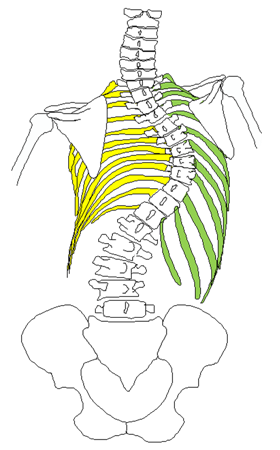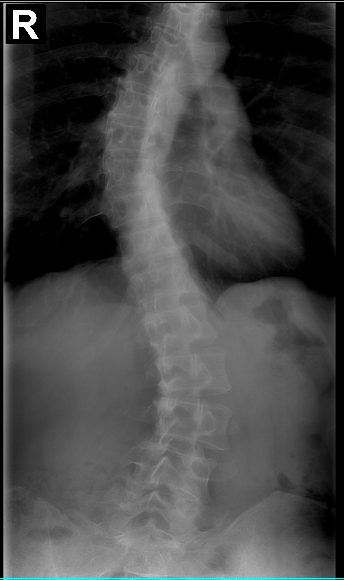Scoliosis is a complex three-dimensional condition of the spine, and about 65% are idiopathic [2].

Scoliosis
Scoliosis
is derived from the Greek word Skolios, meaning twisted. It was Hippocrates (460-375 BC) who coined the term scoliosis for the condition. Scoliosis definition [1] is, in general, an irregular side-bending and twisting of the spine . This side-bending and twisting may be in a shape of an “S” or a “C”, and will consequently affect the position of the ribs, shoulders, pelvis and hips.
Its Appearance

Figure 1
Figure 1 depicts an example of one type of scoliosis. The ribs (green and yellow) are attached to the thoracic vertebrae of the spine. The rotation of the spine forces the ribs to rotate in the same direction. In moderate to severe cases, a “hump” may be visible.
Also noticeable is the appearance of an uneven shoulder level. This unevenness is due to the sideways glide of the thoracic spine. The sideways glide of the thoracic spine is always towards the same side as the “hump”. The side that the spine is glided towards to is called Convex (curved out). The side that the spine is glided away from is called Concave (curved in).
In some cases, the appearance of an uneven hip/pelvis level can also occur. This unevenness is due to the scoliotic curve in the lower spine and shifting in the pelvic bone.
Categories
The type of scoliosis typically falls into one of three categories: Congenital (it was present at birth with anatomical deformity), Neuromuscular (it occurred secondarily from a co-existing neurological disorder such as MS or stroke), or Idiopathic (the cause is unknown).
Types
 Idiopathic scoliosis, which is about 65% of all cases [2], is the most common type of scoliosis. It can appear in infants, children, teenagers or adults.
Idiopathic scoliosis, which is about 65% of all cases [2], is the most common type of scoliosis. It can appear in infants, children, teenagers or adults.
Furthermore, idiopathic scoliosis is divided into other subcategories to pinpoint the exact type: compensated vs. non-compensated, type of curve (C-curve, S-curve, multiple curves), and whether or not the pelvis is involved.
